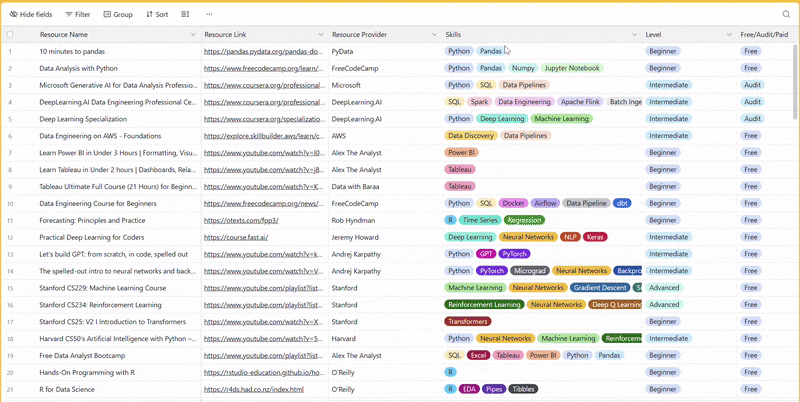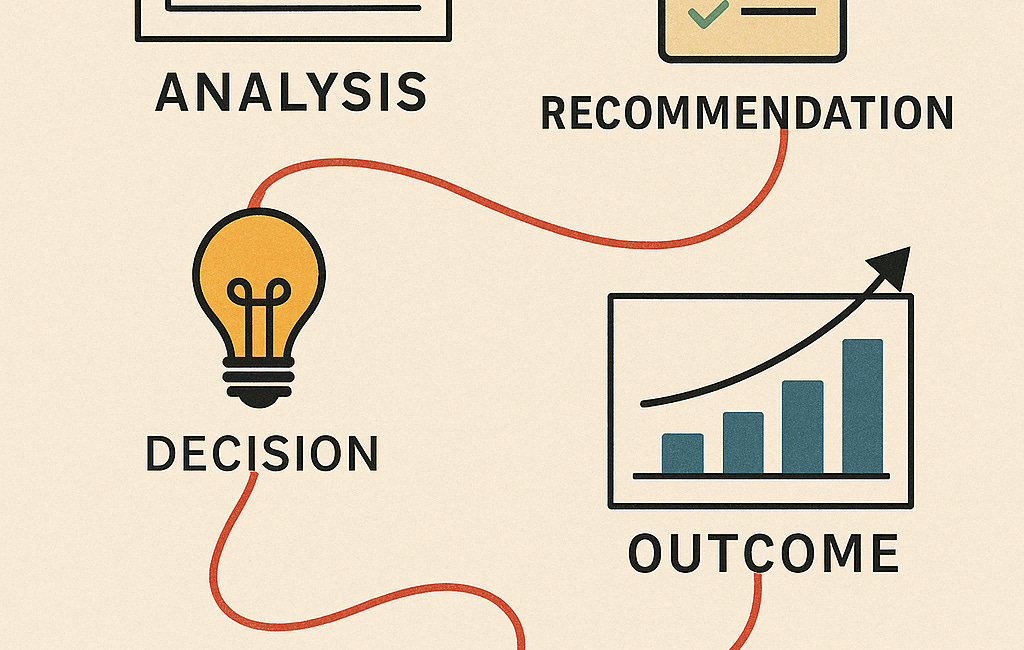The Data Analyst’s Dilemma: Accuracy vs Speed
When is "good enough" actually better than "perfect"?
Fellow Data Tinkerers!
Today we will look at how to strike a balance between speed and accuracy.
But before that, I wanted to share with you what you could unlock if you share Data Tinkerer with just 1 more person.
There are 100+ resources to learn all things data (science, engineering, analysis). It includes videos, courses, projects and can be filtered by tech stack (Python, SQL, Spark and etc), skill level (Beginner, Intermediate and so on) provider name or free/paid. So if you know other people who like staying up to date on all things data, please share Data Tinkerer with them!
With that out of the way, let’s get to the today’s topic of deciding when good enough is good enough!
A familiar fork in the road
Every data analyst has come across this at some point. You’ve been asked to answer a business question. Maybe it’s:
“Why did signups drop last week?”
“Which channel is driving the most high-value customers?”
“Can we predict demand for the next quarter?”
You open your laptop, dive into the data and almost immediately feel that tug of war:
On one side, the voice whispering “don’t cut corners, get the numbers exactly right, otherwise you’ll lose credibility.”
On the other side, the voice screaming “they needed this yesterday, stop tweaking SQL joins and just give them the numbers.”
Accuracy vs speed. Perfect vs good enough. It’s the analyst’s version of the angel and devil on your shoulders.
To be fair, neither side is completely wrong. The business does need answers fast but if those answers are sloppy, you’ll pay for it later. The trick is learning when “good enough” really is enough.
And this matters more than ever
Modern analytics teams don’t suffer from a lack of data anymore. If anything, they are drowning in it. That means:
Questions come faster. The more data you have, the more curiosity stakeholders have.
Timelines shrink. A decision on pricing, campaigns or resourcing rarely waits weeks.
Tolerance for mistakes varies wildly. A marketing test can live with a ±5% margin. A financial forecast? Not so much.
So every analyst ends up playing referee between two competing forces:
Speed (decision-making). Businesses move quickly. Waiting weeks for an analysis can mean a missed opportunity.
Accuracy (credibility). Stakeholders will forgive a slightly delayed report more than they’ll forgive numbers that turn out to be flat-out wrong.
Balancing these is the difference between being seen as helpful versus being written off as the data person who slows everything down.
Why analysts default to perfection and businesses push for speed
If you’ve spent years in data, chances are your instinct leans toward accuracy. You can blame it on training and incentives:
We were taught precision. From stats classes to SQL queries, the focus is usually: don’t ship until it’s correct.
Errors feel personal. One wrong number and suddenly trust in all your future work is questioned.
Dashboards live forever. Even if you publish a flawed dashboard, the mistake can haunt you for months.
So analysts build habits around bulletproof queries, edge-case handling and adding a just-in-case analysis. And this perfectionism often delays results past the point of usefulness.
On the flip side, business stakeholders are wired for speed. And for good reason:
Markets shift. Waiting for a perfect analysis on customer churn while competitors are already poaching your users is a bad look.
Opportunity cost. A rough-and-ready estimate can unlock action today.
Bias toward action. Many execs would rather be ~70% right and move quickly than be 100% right when the moment has passed.
That’s why you’ll often hear things like:
“Don’t overthink it, just give me a ballpark.”
“I need a direction, not a dissertation.”
They don’t mean to dismiss accuracy but are weighing it against the cost of inaction.
Matching rigor to the questions
Here’s the part most analysts miss: not every question deserves the same level of rigor.
Think of analysis like cooking:
Sometimes you need a microwave snack (quick, not fancy, just edible).
Sometimes you need a home-cooked meal (a couple hours, satisfying, reliable).
And sometimes you’re cooking for Michelin-star critics (pull out the sous-vide, sharpen the knives, get it perfect).
Business questions fall into those same buckets:
Exploratory questions (“What’s happening with signups this week?”) = microwave snack. Fast, directional, good enough to spark discussion.
Tactical questions (“Which campaigns should we double down on this quarter?”) = home-cooked meal. Reasonably accurate, a balance of speed and rigor.
Strategic or high-stakes questions (“Should we enter a new market?” “What’s our revenue forecast for next quarter?”) = Michelin-star. These need deep and methodical work.
The key is learning to classify the question before you start. Otherwise, you’ll end up spending 3 weeks perfecting what was meant to be a snack.
Here’s a simple framework you can use to get a sense: impact × timeline × tolerance.
Ask three things before you start:
Impact: How much money, reputation or strategic weight is attached to this decision?
Timeline: How quickly does the business need to act?
Tolerance: How wrong can we afford to be? ±1%? ±10%?
Plot those three and you’ll know the level of rigor required.
High impact + low tolerance = perfect is worth the wait.
Low impact + urgent timeline = good enough, ship it.
Everything else = calibrate. Do enough to be credible without gold-plating it.
Practical ways to balance speed and accuracy
1. Always clarify the level of precision required.
Ask stakeholders: “Do you need an exact number or just directional insight?” You’d be surprised how often directional is enough.
2. Build iterative analysis.
Don’t vanish for two weeks. Share a rough cut early (“here’s what it looks like so far”) then refine if needed.
3. Reuse building blocks.
Have trusted queries, metrics definitions and templates ready. Saves hours of reinventing.
4. Flag uncertainty openly.
If you’re shipping something quick, annotate the caveats. “This excludes mobile traffic” is better than pretending it’s flawless.
5. Keep a feedback loop.
When speed-based decisions succeed (or flop), note what level of accuracy was actually necessary. Over time, this builds judgment.
Example: the churn dashboard
Imagine you’re asked to explain a sudden rise in churn.
If it’s for a weekly ops meeting, you can say: “Early look suggests engagement drop after onboarding. Needs validation but that’s the likely driver.” = fast, directional.
If it’s for a quarterly board report, you’d dig deeper: control for seasonality, segment by cohort, quantify the financial risk. = slower, accurate.
If it’s for a strategic pivot (should we redesign onboarding entirely?), you’d go full Michelin-star. A/B test, model scenarios, validate with external benchmarks.
Same question, different stakes. Your role is to match the rigor to the moment.
The advantage of directional first, precise later
One underrated tactic: lead with a directional answer then follow up with rigor.
Example:
Day 1: “Preliminary data suggests campaign A is 2–3x stronger than campaign B.”
Day 3: “Confirmed: campaign A has a 2.4x lift after controlling for X and Y.”
Stakeholders get to act quickly. You protect your credibility by tightening the accuracy after. Everyone wins.
Wrapping it up
The data analyst’s dilemma isn’t going away. Accuracy and speed will always compete. The real skill is judgment: knowing when to hit 90% and ship and when to grind for that final 10%.
So the next time you feel the tension between accuracy and speed, ask yourself:
What’s the impact of this decision?
How fast do they need it?
How wrong can we afford to be?
Then pick your lane with intention.
Happy analysing!
If you are already subscribed and enjoyed the article, please give it a like and/or share it others, really appreciate it 🙏
Keep learning
How to Show Impact as a Data Analyst
Ever delivered a great analysis and then had no idea if it changed anything?
This one’s for you: how to track impact, prove it and actually talk about it when it matters.
The Alignment Trap: When Stakeholders Want Data but Not the Truth
When “can you pull the data?” really means “can you back up my story?”
This post dives into the Alignment Trap and how analysts can escape it.






We can also microwave home cooked food 😎
(reusing templates-patterns I've been collecting and finding opportunities to be faster next time without sacrificing quality)